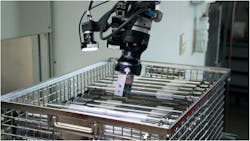HWL Applies Artificial Intelligence to Robotic Material Handling
HWL Löttechnik GmbH (HWL) is a Berlin-based thermal treatment company with customers in the automotive, electronics, aerospace and tool industries. Like many other small and medium-sized businesses in high-mix, low-volume manufacturing, HWL faces growing labor shortages, the ongoing energy crisis and the intricate nature of production processes.
Recognizing the physically demanding and repetitive work involved in its thermal treatment processes and the increased workload for staff due to labor shortages, Kai Lembke, managing director, set out to identify the tasks that could benefit the most from automation. The prime candidate he found for automation was the loading of metal parts onto racks from washing baskets.
Before heat treatment, the serial parts handled by HWL undergo a cleaning process in a cabin washing facility. Each customer typically delivers around 900 to 1,000 parts in large loading carriers, which employees manually transfer into washing baskets. The parts in the baskets are then placed onto multi-tiered racks using a peg system before being transported to the oven for heat treatment.
The diversity in size and weight of the metal parts, combined with their fragile nature prior to heat treatment, makes the handling process extremely complex. This complexity stems from:
• Variance in the size and weight of the components.
• Variance in the positioning of the components within the washing basket.
• Variance in the position of the racks.
• Variance in the appearance of the component due to reflection and changing lighting conditions.
In October 2022, a robot equipped with MirAI took over the task of loading the parts. After the washing process is completed, the MirAI system takes control of the robot. Guided by MirAI, the robot lifts the delicate parts individually from the washing baskets and places them on pegs in the racks. The AI-based vision system automatically adapts to the varying sizes and weights of these highly individualized parts.
Unlike traditional vision systems, changing lighting conditions and reflections on the surface of the workpieces do not affect the functionality and precision of the system.
Since the implementation of MirAI, HWL employees have taken on the responsibility of managing and retraining the system—an important aspect due to changing customer requirements and environmental modifications.
“The fact that these adjustments can be made by our employees without the need for experienced programmers from the manufacturer is a significant advantage,” Lembke said. “We have even been able to optimize cycle times by 20%. By automating processes, we can save costs, position ourselves as a progressive and modern company, and enhance the attractiveness of our workplace.”

